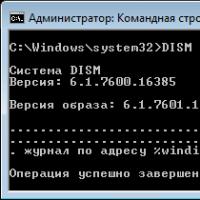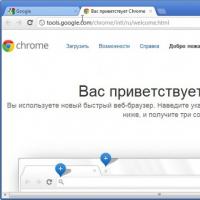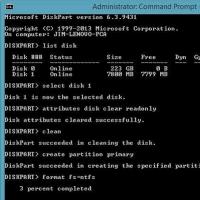Context menu registry. Detailed analysis of Windows context menu options
Explorer's context menu is the menu that appears when you click RMB (Right Mouse Button) on some object (file or folder) or simply on an empty space in a folder or Desktop. If your system is new, then the context menu will be relatively empty. Is that just added from the drivers for the video card, for example like this:
but if the system has been installed for a long time, then there will be more such points. For example like this:

As you can see, over time, in addition to the standard menu items, more from installed programs were added. On the one hand, it's convenient. After all, you do not need to launch a shortcut or search for a program, but you can directly perform actions immediately from the context menu. But on the other hand, over time, there are a lot of such items, and sometimes the context menu even has to be scrolled up or down in search of the necessary items.
Therefore, sometimes you want to remove these items so as not to interfere. After all, you do not use all the points often.
So how remove item from context menu.
In order to remove a program item from the context menu (KM for short), you can use both the standard methods of the Operating System itself, and using the programs themselves or specially designed ones.
The easiest thing to remove is to look in the settings of the program (which you want to remove) for the desired item. It is usually located somewhere in Integrations or Upload/Add. For example, in order to remove the item of the famous WinRAR from KM, you need to uncheck Shell integrations:

Other programs may also have similar settings.
Another thing is when you did not find the necessary settings for deletion or they do not exist at all (it happens sometimes). Then you can use the standard method of the systems itself, namely editing.
I warn you right away that before starting work it would be better to play it safe and make a backup copy of the registry.
So, we launch the registry and go to the branch
HKEY_CLASSES_ROOT/*/shellexe/ContextMenuHandlers

and see here these same items from the context menu.
Now we right-click on the desired item (the item from the CM that you want to delete) and select Delete:

We agree with the following warning:

reboot and check. The point should be gone.
If not gone, then look at the branch
HKEY_CLASSES_ROOT\AllFileSystemObjects\ShellEx\ContextMenuHandlers
and do the same.
On a note:
If you want to delete an item specifically from CM -> Create

then you need to know the type of file () that is being created. For example, for Microsoft Office Access, the file extension is .accdb, which means you need to look for it in the HKEY_CLASSES_ROOT registry branch, and delete the ShellNew subsection there

If you want to remove from the KM those items that appear when you RMB on folders, then you need to look at the branches:
HKEY_CLASSES_ROOT\Directory\shell
HKEY_CLASSES_ROOT\Directory\shellex\ContextMenuHandlers
HKEY_CLASSES_ROOT\Folder\shell
HKEY_CLASSES_ROOT\Folder\shellex\ContextMenuHandlers

For the "Open with ..." item, the branch answers
HKEY_CLASSES_ROOT\*\OpenWithList
For KM Logical Disks branches:
HKEY_CLASSES_ROOT\Drive\shell
HKEY_CLASSES_ROOT\Drive\shellex\ContextMenuHandlers

You can also delete items using special programs. For example using ShellExView

Its principle is simple: select the desired item and click on the red circle at the top of the program. The main thing here is to Type of was Context menu

Now a little about how create your own item in the context menu.
The fact is that adding such an item for folders or certain files, as well as on an "empty" place using the registry, will not work. You can only assign it to when it opens with RMB on the Desktop. Therefore, I recommend reading the article and using what is described there.
Well, or use another utility - Ultimate Windows Context Menu Customizer() which has a bunch of features, but in English. And there we only need to select the item and delete it:

If you are interested in more details and do not understand, then write in the comments and I will help. There, in the left column, you need to select the item (computer, folder, files, etc.) where the context menu is called, and to the right, select what to delete and click the Remove Item button at the bottom. If you are friends with English, then you will understand.
You can guess how to add your program to KM -> Create if you carefully read the entire article, namely about deleting one of this item. You just need to create a subsection on the contrary and write for the desired extension.
In general, the article turned out to be a little chaotic and more about removing from the context menu, because. I think that this is more relevant, and there is an article about adding. Therefore, if something is not clear - write in the comments. Let's figure it out.
The context menu (right-click menu) is a handy tool for speeding up work in Windows. Today we will reveal some simple secrets of working with the context menu and the system registry. Read how to customize this important element to your needs without third-party applications, using only the built-in regedit registry editor.
What is the convenience of the context menu (right-click menu) and why clear it
I would like to immediately decide on the terminology, so that in the future there will be no confusion.
Explorer's context menu, or action menu as it is sometimes called, is a set of commands invoked by clicking right(contextual) mouse buttons on any file or folder. Depending on the object for which it is called, the menu will have a different look or "context".
Note. Of course, not only Windows Explorer has an action menu, but also most installed applications, because this is the most convenient way to access the most important commands.
Immediately after installing the operating system, the context menu has a standard and neat appearance, but as additional software is installed, new items are constantly added to it. In the end, there are so many of them that the use of this useful tool turns into flour. Therefore, it is critical to be able to maintain the contents of the Windows context menu in order for fast and comfortable work.

This can be done in two ways:
- In semi-automatic mode, using third-party software.
- Manually, using the Windows Registry Editor.
Perhaps the first method can be a little easier, but the second method does not need to use various dubious programs downloaded from the Internet, everything is done by standard means.
Moreover, using the registry will allow you to delve deeper into the internal processes of the system and learn a lot of new things, so we will talk about the second option.
How to edit the Explorer context menu through the registry
We start the registry editor:
- Entering the menu P usk.
- Enter the command in the search bar regedit and press Enter.

Important! Any careless and thoughtless operations can have dangerous consequences, up to a complete failure to boot Windows. To insure yourself against errors, be sure to back up the registry before editing it!
The procedure for creating a backup registry file:
- Go to menu " File» in an open editor.
- Select the item " Export».
- In the window that opens, in the lower field " Export Range”, choose “ Whole registry».
- Specify the desired location and name of the new file and click " Save».

Note.In case of problems after manual editing, the registry can be restored to its original state from a backup using the " Import" on the menu " File» editor regedit.
As you can see, the registry itself has an original tree structure. The tree itself is displayed on the left side of the editor, and the list of parameters in the selected branch is displayed on the right side. To work with the context menu, we are interested in a single section: " HKEY_CLASSES_ROOT».

As already mentioned, different sets of commands correspond to different objects (folders, files), so they will have to be edited in the registry separately. Our main goals: clear folder context menu and common menu items for all file types.
Important! We will not change the standard system context menu items through the registry. Only items added by installed applications are edited.
Folder Context Menu Cleanup
All directory context menu settings are stored in branches:
…Direct Shell.
... Directory Shellex ContextMenuHandlers .
… Folder Shell ex ContextMenuHandlers .

If you look closely, it is easy to see familiar commands among the branches of these branches. So, a branch of the registry " Directory Shell" contains the items at the top of the menu, and " Directory Shellex ContextMenuHandlers"- bottom. " Folder ShellEx ContextMenuHandlers”, basically repeats the content of the previous branch, so delete the same items from both branches if necessary.
It remains only to remove the extra commands. The choice of what to remove and what to leave on the list is already a personal matter for everyone. Moreover, depending on the list of installed applications, the contents of the menu will differ significantly. Right-click on the registry entry you don't want and select " Delete". Then repeat this operation for the remaining selected elements.

This is the neat look of the registry branches in question and the menu itself after the cleaning procedure is completed.

File context menu cleanup
The procedure itself is no different from the one that was carried out in the previous section. Only branches of the registry branch " HKEY_CLASSES_ROOT”, which store the necessary parameters.
Now this:
…*shellexContextMenuHandlers.

They store common elements for all file types registered in the system.
Following the example of cleaning for folders, we delete all unnecessary branches in the registry and get a beautiful and convenient context menu.

Many people like the Windows operating system, and many of us grew up with it. But some casual PC users - or those who have just switched to Windows - often get confused looking for information about some of the simple things that run Microsoft's operating system. One of these widget elements is called the "Windows context menu" or "right-click menu".
Today we will tell you not only about this integral element of interaction with Windows, but also about a third-party application that allows you to add custom elements to the context menu.
So what exactly is the Windows context menu?
In simple terms, this is a pop-up menu that appears when you right-click in any navigation area of the screen (hence the name "right-click menu"). The context menu can be accessed from folders, the taskbar, web browsers, and other areas of the GUI. The context menu is not exclusive to Windows, so you may have seen it on other operating systems, including Mac OS X or Linux.
Speaking about the appearance of the Windows context menu, it looks almost the same everywhere - only the elements inside it differ. For example, the screenshot below shows the context menu that opens when you right-click on the desktop, say to set the desktop background image in the Personalize window.
Usually, the context menu carries such elements as "View", "Sort", "Copy", "Paste", "Rename", "Properties", etc. Some of the menu items are context based. In other words, in one of the areas of the operating system, the context menu may contain some items, and in another - already others. For example, the menu that pops up when you right-click on the taskbar will contain completely different items compared to the menu that you see in the screenshot below.

Here is another simple example of the context menu that appears when you right-click on a folder:

Now that you've learned what the context menu in Windows is and how it works, let's take a look at a handy and free application with which you can easily customize the menu.
A portable application that allows you to add custom items to the "right-click menu" in Windows 7, Windows 8 and Windows 8.1 was developed by Sergey Tkachenko (WinAero) - a well-known developer who is the author of many useful tools, including . The application is very convenient in the sense that the whole process of adding items to the context menu requires several clicks from the user.
To get started, launch the application. The Context Menu Tuner interface consists of two different panels - the left one contains a list of supported commands, and the right one consists of Windows Explorer panes. To add a command, you need to select one of them in the left panel, and then, after selecting your preferred element in the right panel, you must click on the "Add" button. As you might guess, the "Delete" button is responsible for deleting the added commands.
Additional features of the application allow you to add separators before and after certain menu items. In addition, there are a couple of additional options.

Another interesting feature of the application is its ability to add custom commands for specific file types. When you open the "Select File Type" window, accessed by clicking on the "Append -> Append to Specified File Type" button in the application's main window, you'll see an impressive number of file extensions supported. The list is very long, so to quickly find a specific file type, use the search bar.

The screenshot below shows my context menu, which I modified using the Context Menu Tuner:

That's all. Now you know what the Windows context menu is and you know a simple solution to edit it.
Have a great day!
Absolutely all computer users are faced with the concept of a context menu, regardless of the type of operating system used or its developer. Such an element is available in all currently known operating systems. But let's see what the Windows context menu is, what types it is and how to deal with it. We take Windows as a basis only for the simple reason that most users in the post-Soviet space work with just these operating systems. And first, a few words about the term itself.
What is a context menu in general terms?
Actually, the name of the menu itself comes from the English context. As for a simplified understanding, the context menu of Windows 10 or any other operating system can be interpreted as some additional element of the system's graphical interface, in which there are certain commands for quick access to some basic or additional functions.
So to say, in the context of selecting an object for which an additional menu is used, various commands will be available (this will be discussed separately).
Menu types
Actually, the operating system itself has several types of main and additional menus. For example, the main menu is accessed by pressing the "Start" button. Installed programs usually have their own element in the form of a top panel, which displays sections of basic operations, etc. Naturally, all such menus differ in appearance and purpose. But it is the context menu that is universal in its own way and in a sense even connects applications to the operating system without the use of additional tools. Forgot how to perform some action? It's OK! This menu will tell you what to do and how, especially since many menus of this type can open additional lists.
Context menu items
As already mentioned, for different objects, the content of the menu can differ quite a lot. It all depends on the type of the selected object and the actions that are supposed to be performed. Everyone knows that in Explorer, through such a menu, when a file or folder is selected, you can set copying, moving, deleting, opening and performing a lot of other operations, except for using hot keys or their combinations.

On the "Desktop" when you click on an empty area of the screen, you can quickly call up the screen settings or create shortcuts. But to perform such actions, following the standard methodology, it will take much more time. In general, as it is considered, the context menu is a unique invention. Despite the fact that almost all the items contained in it are duplicated both by the operating system itself and by some installed programs, its use often reduces the time to access certain actions and functions.
Differences between menus for different objects
Now let's consider the most important question regarding how menus of this type differ when a particular object is selected. It goes without saying that it will not be possible to describe all types, so we will focus on the most basic ones.
With files and folders sorted out a little. You can add that antiviruses, archivers and some other programs embed their own commands in such menus, so in addition to a set of standard actions, you can use their additional features.

If you use the menu for a disk or partition, you can already access the system tools here. Programs have their own elements of this type, however, the context menu for almost all active applications, if the upper left corner of the program window on the header is used as the selected object, the items are the same: closing, moving, minimizing and maximizing the active window, resizing, etc. It is clear that the content of each context menu for applications depends on the specifics of using the program. So, in web browsers, among the items, there are commands related specifically to actions with tabs or settings.

When using the menu for panels, it becomes possible to configure them, go to additional options, add or remove elements, etc. As already mentioned, it is physically impossible to describe the content of all types of opened menus, so let's move on.
How to open an additional menu: a few basic ways
Now a few words about how to call or open the context menu. Everyone knows that Windows uses RMB for this (clicking on This action is set in the default settings, although some use button reassignment, after which this control is called with the left button. In general, the mouse context menu, depending on the type used For example, for the same gaming mice, which have a lot of additional buttons, the accompanying software is usually installed, which allows you to control all their parameters and configure the buttons for a specific action, including calling additional menu.
Few people know that in Windows you can use not only RMB. For example, for laptops, it is very important to use the Shift + F10 combination. Also for this is the right button on the touchpad. On some non-standard keyboards for stationary computer terminals, you can find a special Menu key, which is usually located to the right of the Win button.
How to add additional items to the menu?
Finally, let's see how to add additional items or commands to the context menu. You can, of course, use Windows tools, but for this you have to delve into the registry, and this is very inconvenient.

The easiest way is to use the small program Context Menu Tuner, the interface of which consists of only two panels with command sets and areas of Windows Explorer.

To add or remove elements, there are only two buttons, so there should be no difficulties in using.
Practical Benefits
As for the advantages, a lot has already been said about them. This applies not only to the fact that the correctness of calling some actions can simply be forgotten. The versatility of such menus consists precisely in accelerating access to some standard and non-standard functions or actions, which would take much longer to call in the usual way. And so - RMB and all the necessary commands at hand!
Instead of total
I would like to hope that after reading the above material, many have figured out what this element of the operating system is. As for its use, there should be no questions at all, since in some situations you simply cannot do without it. And practice shows that one hundred percent of users out of a hundred always use the context menu, regardless of the actions performed.
Cleaning up the context menu can be done manually through the registry, but this task is not trivial, since the entries are scattered in different places. In addition, it is not always easy to identify the appropriate registry key. For example, drivers are registered through the abbreviation "igfx". Registry entries are scattered under the "HKEY_CLASSES_ROOT" branch in the "shell" or "shellex" folders, which contains a folder called "ContextMenuHandlers" that also includes some options.
Reducing the context menu through the utility for working with the registry
It will take a lot of time to manually process the lines of the context menu. It is much easier to use the ShellExView program. Through regedit it is worth changing only system options.
To detect items from third-party programs in ShellExView, sort the results by the "Company" parameter and in the "Type" column, find "Context Menu".
The free ShellExView utility will compile a single list of all these registry lines. Even on a relatively fresh system, their number can exceed 250. In order not to get lost in them, after starting the program, the records should first be sorted. Things will go smoothly if you click on the line “type” at the top of the window. Thus, you will immediately see all possible entries in the registry, related, for example, to the "Context Menu". But be careful: along with them, the utility will display lines from Shell, which are better not to touch.
Sorting can also be done by the "Company" parameter. In this case, the results will be arranged in alphabetical order - the records created by the system and marked as "Microsoft" are easy to distinguish from the rest. You can here, for example, highlight the corresponding "igfxDTCM Module" and disable it by clicking on the red dot at the top of the menu bar. After that, the entry for the (practically useless) Intel driver graphics options will disappear from the context menu. However, for the system to apply these settings, you must first log out and then log back in. Alternatively, you can disable "explorer.exe" through the Task Manager, and then call this service again.
Changing system context menu items

Most of the lines in the context menu are created by the system itself. Among them are also options that no one uses, which, however, I would not want to accidentally activate by mistakenly pressing. You cannot simply get rid of them through the ShellExView program - you will have to manually modify the registry.
A good example is the "Submit" option that Windows shows every time the user clicks on a file or folder. Keep in mind that some of the sending options are not up to date with today's needs: the default is "Fax Destination" in general.
To remove this item from the menu, in Regedit navigate to "HKEY_CLASSES_ROOT | AllFilesystemObjects | shellex | ContextMenuHandlers | SendTo. In the right window, double-click to open the "Default" option and before the long sequence of characters in curly brackets, put a modest minus sign "-" to turn it off. As always, you must log out of Windows and log back in.
 How to Fix Windows Update Installation Errors Using Built-in Component Repair
How to Fix Windows Update Installation Errors Using Built-in Component Repair Free programs for Windows free download
Free programs for Windows free download Proven ways to remove protection from the drive
Proven ways to remove protection from the drive how to change windows startup ringtone how to set windows ringtone
how to change windows startup ringtone how to set windows ringtone Nokia lumiya blacklist in classmates
Nokia lumiya blacklist in classmates How to get a replacement phone under warranty
How to get a replacement phone under warranty Sony Xperia Tablet S - Specifications
Sony Xperia Tablet S - Specifications